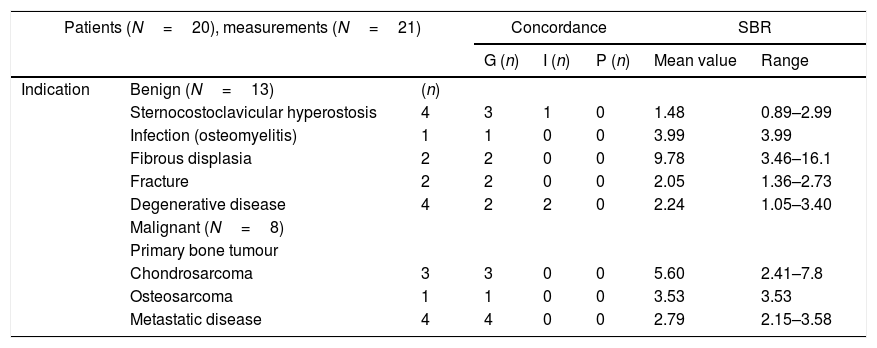To assess the feasibility of using freehand Single Photon Emission Computed Tomography (freehandSPECT) for the identification of technetium-99m-hydroxydiphosphonate (99mTc-HDP) positive bone lesions and to evaluate the possibility of using these imaging data-sets for augmented- and virtual-reality based navigation approaches.
Material and methodsIn 20 consecutive patients referred for scintigraphy with 99mTc-HDP, 21 three-dimensional freehandSPECT-images were generated using a handheld gamma camera. Concordance of the two different data sets was ranked. Furthermore, feasibility of segmenting the hotspot of tracer accumulation for navigation purposes was assessed.
ResultsIn 86% of the cases freehandSPECT images showed good concordance with the corresponding part of the scintigraphic images. In lesions with a signal to background ratio (SBR) >1.36, freehandSPECT provided an automatically segmented reference point for navigation purposes. In 14% of the cases (average SBR 1.82, range 1.0–3.4) freehandSPECT images showed intermediate concordance due to difficult anatomical area or negative bone scintigraphy and could not be used as navigation targets.
ConclusionIn this pilot study, in 86% of the cases freehandSPECT demonstrated good concordance with traditional scintigraphy. A lesion with a SBR of 1.36 or more was suitable for navigation. These high-quality freehandSPECT images supported the future exploration navigation strategies, e.g. guided needle biopsies.
Determinar la factibilidad de la freehandSPECT en la identificación de lesiones óseas con captación de 99mTc-HDP evaluando los datos generados mediante la utilización de sistemas de navegación con realidad aumentada y virtual.
Material y métodosSe generaron 21 imágenes 3D utilizando freehandSPECT con una gammacámara manual en 20 pacientes referidos para gammagrafía ósea con 99mTc-HDP. Las imágenes freehandSPECT y las gammagrafías fueron comparadas y se analizóel grado de concordancia. Además, se evaluó la factibilidad de navegación hacia las lesiones óseas hipercaptantes.
ResultadosEn el 86% de los casos freehandSPECT mostró una buena concordancia con las imágenes correspondientes de la gammagrafía ósea. En lesiones con una señal lesión/fondo de >1,36 freehandSPECT pudo automáticamente proporcionar puntos de referencia segmentados con finalidad de navegación. En el 14% de los casos (índice lesión/fondo: valor promedio 1,82, rango 1,0-3,4) las imágenes freehandSPECT mostraron concordancia intermedia debido a que estaban localizadas en regiones anatómicas difíciles o asociadas con una gammagrafía ósea negativa y fueron consideradas como no apropiadas para la navegación dirigida.
ConclusiónEn este estudio piloto, se encontró un 86% de los casos apropiados para propósitos de navegación con una buena concordancia entre freehandSPECT y la gammagrafía ósea. Un índice lesión/fondo de 1.36 o más facilitó la navegación con freehandSPECT. La alta calidad de las imágenes generadas con freehandSPECT potencialmente asegura una exitosa estrategia de navegación para biopsias óseas guiadas.
Article
If you experience access problems, you can contact the SEMNIM Technical Secretariat by email at secretaria.tecnica@semnim.es or by phone at +34 619 594 780.

Revista Española de Medicina Nuclear e Imagen Molecular (English Edition)










